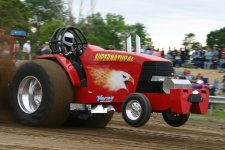CalG
Super Member
- Joined
- Sep 29, 2011
- Messages
- 9,181
- Location
- vermont
- Tractor
- Hurlimann 435, Fordson E27n, Bolens HT-23, Kubota B7200, Kubota B2601
Is the pivot point the bottom of the rear tires? Everyone thinks its the center of the wheels where it connects to the hub.
Pivot Point is defined as the center point of any rotational system.
Now, there is a thought problem! ;-)
Consider the extreme conditions.
First, Engine off , Transmission in neutral, a "tractor jack" (fork lift, hoisting crane, I don't care) Lifting the front axle of the tractor. Rear wheels are "chocked" with 8X8 blocks. Raising the front end, would show that the tractor "pivots" on the rear axle.
Second, Same conditions regarding the tractor, but instead of a hoist out front, put a long bar out back, ridgidly fixed to the tractors axle implement mounting pads. Pressing DOWN on the lever arm causes the front of the tractor to rise. The whole shebang pivoting around the rear axle center. The WHEELS are still chocked!
Third. Put the mechanical transmission in low, Lock the engine flywheel and don't let anything "inside" the tractor turn.
Remove the chocks. Any lifting of the front, or levering down out back will have the tractor pivoting about the TIRE CONTACT PATCH. At Ground level!
Actually, It would be difficult to arrange a situation that is a cross between the pivot points that present themselves in the above "Thought Problem".
So, for my money, When pulling an "over load". The engine torque can act at as a locked transmission, rolling the tractor around the ground contact point. But any difference in speed over the ground relative to wheel rotation (slip + or -) manifests as a pivot about the axle.
The important for safety aspect would be to keep the slip going in the correct direction. i.e. slipping clutch, or hydro drive if fitted.
A nice long draw bar sticking out past the rear wheels answers every requirement. 3pt pulling is deadly.

